Costco and Walmart have both carved out enormous footprints in the global retail landscape, each taking a unique path to reach the top. Walk into a Costco warehouse on a weekend, and you’re immediately enveloped by the hum of bustling shoppers, oversized carts, and towering stacks of bulk merchandise. The layout is simple: tall steel racks, concrete floors, and massive palettes laden with enough toilet paper, snacks, and bottled water to stock a small corner store for weeks. Meanwhile, step into a Walmart, and you might find yourself in a brightly lit Supercenter featuring everything from groceries and pharmaceuticals to car tires and school supplies—all accessible without a membership fee. These two titans of American retail dominate many communities, shaping how millions of families shop for their everyday needs.
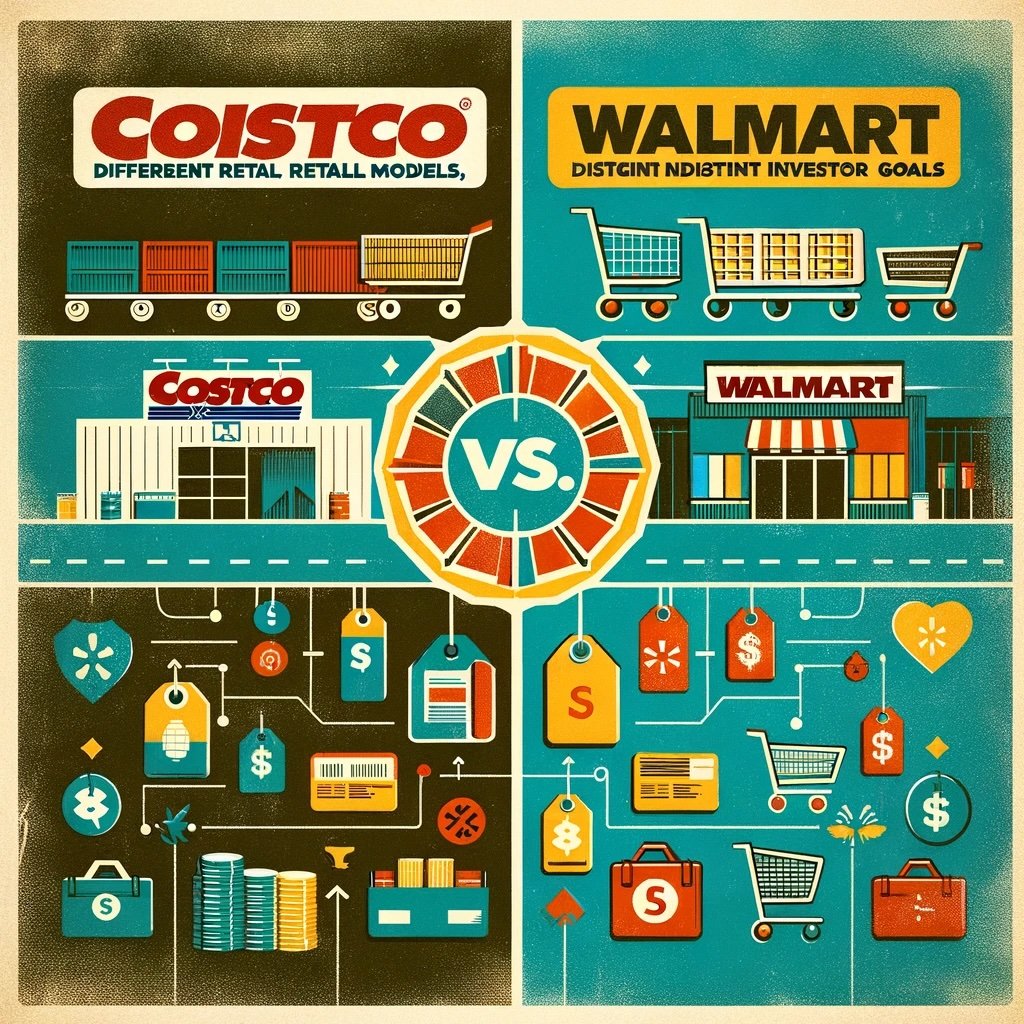
But they do so in distinctly different ways. Costco relies heavily on its membership-based model, which fosters loyalty and repeat business by offering exclusive savings to those who pay an annual fee. In contrast, Walmart takes pride in making products affordable and accessible to everyone, using its enormous scale to negotiate extremely low prices. Each model brings its own set of advantages and challenges, influencing everything from the stores’ layouts to their pricing structures to the types of customers who walk through the doors. And it’s not just about day-to-day shopping; for investors, these differences can translate into very different risk profiles and reward structures.
We’ll delve into how Costco and Walmart each operate, focusing on the fundamentals—business models, revenue streams, and customer demographics—before exploring their relative strengths and weaknesses from an investment perspective. By understanding these two companies in depth, both frequent shoppers and prospective investors can make more informed decisions about where to spend, where to invest, or even where to work.

Retail Has Changed Over The Years
Retail has changed significantly over the last decade, with technology, economic pressures, and shifting consumer tastes re-defining how people shop. Online shopping is growing at a meteoric pace, and services like same-day delivery or in-store pickup have transformed the conventional in-store experience. Costco, known for selling goods in large quantities at competitive prices, relies heavily on foot traffic within its warehouses. Walmart, on the other hand, has made massive investments in e-commerce, third-party marketplaces, and digital integration in an effort to maintain its “one-stop shop” advantage. In each case, the end goal is to retain loyal customers while continually expanding profit margins—no small task in an industry with notoriously slim margins.
We will address the following themes:
- Business Models: How membership fees and bulk purchasing define Costco, and how high-volume retail and global scale drive Walmart.
- Revenue and Profitability: Where does the money come from, and why do they both seem to thrive despite intense competition?
- Customer Base: Why some shoppers happily pay for the Costco experience, and others prefer Walmart’s broad-based accessibility.
- Investment Perspectives: A look at historical stock performance, dividend policies, and future growth prospects for each.
- Conclusion: A synthesis of which type of investor might favor one over the other—or how both could simultaneously find a place in a balanced portfolio.

Business Models: A Tale of Two Strategies
Costco: Membership-Driven, Bulk-Oriented
Costco stands out in the retail world primarily due to its membership-based model. Before a customer even steps foot into the shopping area, they’ve already paid for the privilege. This annual fee, which can range from a basic membership to executive tiers with additional perks, provides Costco with a reliable revenue stream that’s less susceptible to seasonal shopping fluctuations. In essence, the membership fee creates a unique psychological effect: consumers who’ve paid upfront for membership feel incentivized to maximize their returns by shopping there frequently, presumably saving more in the long run.
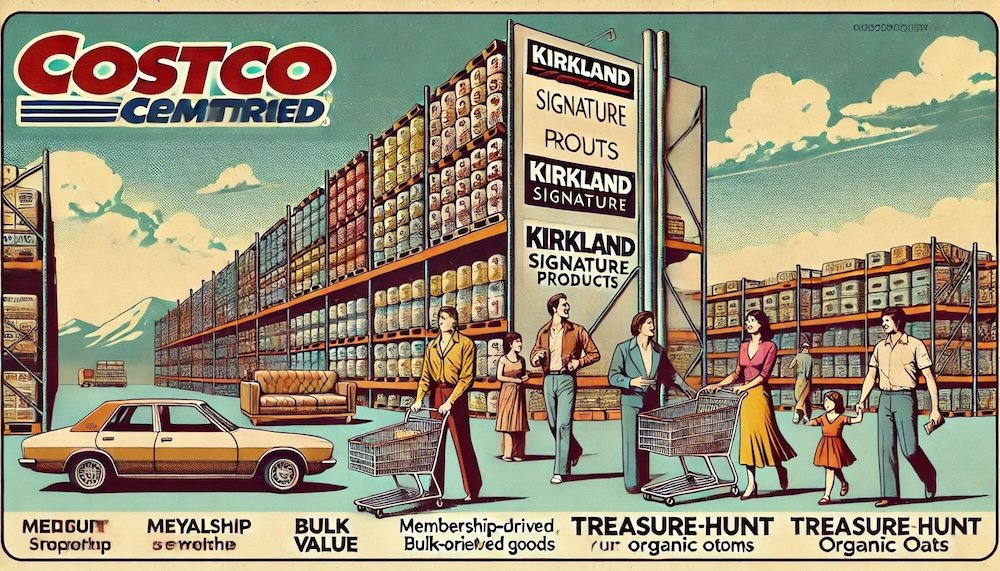
Also central to Costco’s approach is the concept of bulk sales. Shoppers aren’t just buying a single tube of toothpaste; they’re often purchasing an entire pack of six, sometimes for only a slightly higher cost than a single tube at a traditional retailer. This high-volume model caters to families, small businesses, and anyone who has the storage space to handle large quantities of goods. The warehouse design—minimal decor, items stacked on metal racks, minimal signage—further reinforces the wholesale feel, suggesting to shoppers that the savings are passed on to them rather than spent on elaborate store displays.
The curated selection at Costco also helps simplify the shopping experience. In a typical warehouse, Costco might stock only one or two leading brands for a given product category, plus its own private label, Kirkland Signature. This contrasts sharply with the dozens of brand options offered by more traditional supermarkets. By focusing on a streamlined array of products, Costco can buy in immense bulk from each supplier, achieving favorable wholesale pricing. Moreover, limiting SKUs (stock-keeping units) simplifies logistics, helps maintain store organization, and allows for faster turnover, which keeps products fresh and reduces overhead.
Finally, the treasure-hunt aspect of Costco—where certain items appear on a limited basis or rotate in and out of inventory—encourages shoppers to explore new sections or pick up something interesting while they can. You might find an Italian-made leather couch next to a bulk box of organic oats. This approach creates a sense of urgency and novelty, driving higher impulse buys. When combined with the membership model, these strategies yield loyal, high-spending customers who can significantly contribute to robust quarterly earnings.
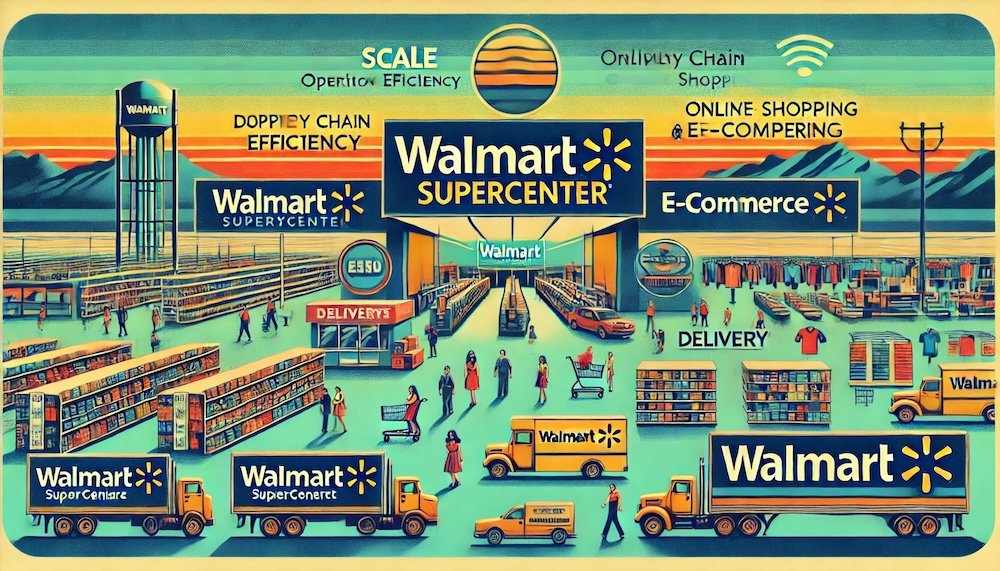
Walmart: Scale, Operational Efficiency, and Accessibility
Walmart, by contrast, takes a more universal approach, epitomized by the slogan “Everyday Low Prices.” Where Costco focuses on membership exclusivity and bulk-packaged deals, Walmart aims to be the place where “everyone” can shop—whether they’re budget-conscious or time-strapped or simply want a single store that sells nearly everything. Walmart’s operational model hinges on its massive scale: the company leverages its size to negotiate extremely competitive terms with suppliers, passing those savings on to consumers.
A key hallmark of Walmart’s operations is its emphasis on supply chain efficiency. With thousands of stores across the United States and a large global presence, Walmart has developed an intricate system of distribution centers equipped with advanced inventory management technology. It’s not just about having a lot of stores; it’s about ensuring those stores are stocked appropriately, minimizing excess inventory, and distributing goods in a manner that keeps transportation costs low. This sophistication helps Walmart maintain thin profit margins on individual items while still generating impressive overall profits thanks to high volumes.
Walmart’s store formats also vary to target multiple market segments. Supercenters offer a combination of groceries, general merchandise, electronics, clothing, and sometimes even auto services. Smaller Neighborhood Markets concentrate on groceries and pharmacy-related products, offering convenience for those who don’t want to navigate a massive store. Meanwhile, Sam’s Club, a membership-based warehouse chain under Walmart’s umbrella, competes directly with Costco. This multi-pronged approach allows Walmart to address different consumer needs, whether it’s a quick trip for milk or a more involved run for back-to-school supplies and a TV for the living room.
In addition, Walmart has made significant pushes into e-commerce, acquiring Jet.com in 2016 and integrating digital platforms to compete with Amazon, Target, and other online retailers. Walmart’s website and app now offer online grocery ordering, same-day pickup, and home delivery in many markets. Because Walmart aims for inclusivity, the addition of digital channels helps the retailer remain a viable option for households that seek convenience and are increasingly moving purchases online.
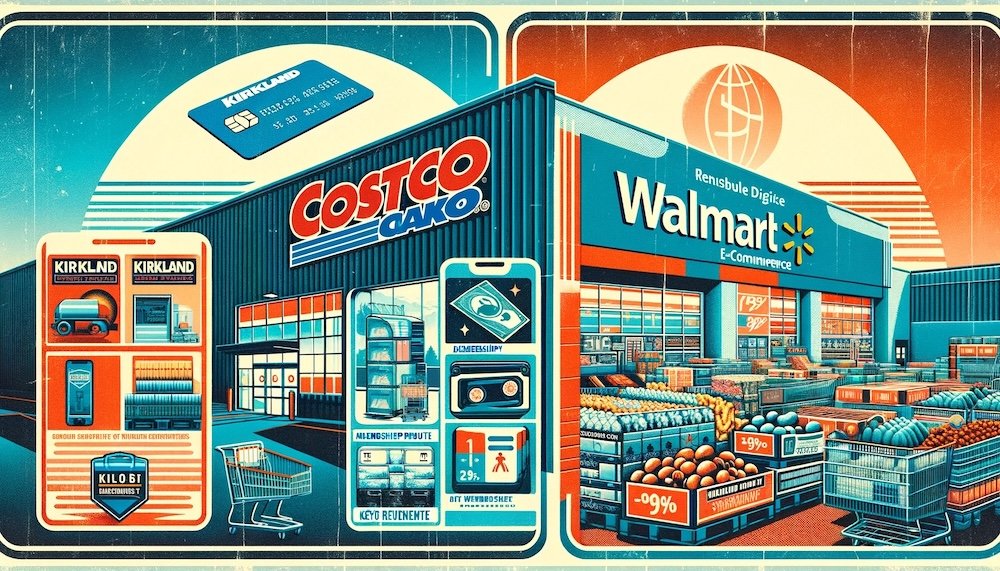
Revenue Streams and Profitability
Core Revenue Drivers
Costco’s dual revenue pillars—merchandise sales and membership fees—serve as the backbone of its financial model. The merchandise side largely comprises bulk-packaged items ranging from snacks to large appliances, while membership fees create a dependable baseline of income. This baseline can be significant; for many quarters, Costco’s membership fees alone have compensated for the low margins on in-store merchandise, essentially funding the competitive pricing customers enjoy.
Walmart’s revenue drivers are more diverse:
- In-store sales across numerous departments, such as groceries, apparel, electronics, health and beauty, pharmacy, and home goods.
- E-commerce operations, including online groceries, third-party marketplace sellers, and other digital services.
- Financial and ancillary services, like check cashing, money transfers, and product warranties.
- Sam’s Club membership and sales, which mimic Costco’s membership-based approach but remain a smaller part of Walmart’s overall portfolio.
For both companies, groceries are a critical anchor. Groceries drive frequent visits and can create cross-selling opportunities for non-food items. Shoppers who come in for eggs or bread may also browse electronics, pick up apparel, or grab cosmetics on the same trip. Groceries tend to have razor-thin margins, but they boost traffic and attach rates for higher-margin products.
Profit Margins: Slim vs. Slimmer
Profit margins in discount retail are famously slim, with net margins for these companies often hovering in the low single-digit percentages. Costco typically keeps margin targets around 2–3% on most products. This is substantially lower than traditional grocery stores or specialty retailers might manage. However, the membership fees add a crucial layer of profitability, partly because those fees, once collected, represent near-pure profit (after some administrative and marketing costs).
For Walmart, margins can be even tighter on many items, especially given the imperative to maintain “Everyday Low Prices.” Where Walmart gains a competitive advantage is in its buying power and operational efficiency. By purchasing goods in enormous quantities, employing advanced logistical systems, and optimizing labor costs, Walmart is often able to preserve or even slightly expand its profit margins over time. E-commerce can complicate matters, though, due to higher shipping costs, return logistics, and the ongoing technology investments needed to keep up with Amazon and other digital competitors.
The Role of Private Label Brands
Private labels, also known as store brands, play a surprisingly important role for both companies. Costco’s Kirkland Signature has developed a dedicated following and is often lauded for quality that rivals or exceeds national brands at a lower price point. Kirkland spans numerous categories, from coffee and laundry detergent to liquor and health supplements. These products can carry higher margins for Costco because there’s no third-party brand owner taking a cut.
Walmart’s private labels include the well-known Great Value for groceries, Equate for health and personal care items, and Parent’s Choice for baby products. While Walmart has historically emphasized cost savings more than premium positioning, it has also experimented with higher-end offerings in certain categories to capture different market segments. The flexibility of private labels allows Walmart to fill various price and quality tiers, but its branding strategy generally revolves around broad accessibility rather than exclusivity.
Geographic Influence on Profit
Costco’s international expansion has been relatively cautious. Outside the U.S., the company has a strong presence in Canada and also operates warehouses in regions like the United Kingdom, Japan, South Korea, Australia, and parts of Europe. Each new warehouse represents a significant investment; however, the membership model demands that new locations be sited where there’s sufficient buying power. Thus, you tend to see Costco in more affluent urban or suburban zones, ensuring membership sales can sustain the operating costs of a large warehouse.
Walmart boasts a broader global footprint, although not without challenges. Walmart operates in Canada, Mexico (Walmex), Central America, parts of South America, the U.K. (previously through Asda, which it has since divested in part), China, and beyond. Different markets can offer different margins, regulatory hurdles, and cultural nuances. While international diversification can insulate Walmart from regional recessions, it also exposes the company to economic volatility, currency swings, and competition from formidable local players.
E-Commerce and Digital Sales
In the modern retail landscape, e-commerce is often the “make-or-break” factor for many large-scale retailers. Walmart has been aggressive in this arena, integrating physical and online channels to provide same-day pickup, home delivery, and broader product assortment through third-party marketplace listings. These investments have improved Walmart’s digital presence, allowing the company to go head-to-head with Amazon for consumer dollars. E-commerce is still a smaller fraction of Walmart’s overall revenue, but it’s growing steadily and is a major focus for future strategy.
Costco has traditionally lagged in e-commerce. Much of its appeal lies in the in-warehouse experience and the bulk-buying concept, which doesn’t always translate perfectly to online retail. However, Costco has recognized the importance of a web presence, offering some categories online (especially electronics, furniture, and non-perishable items) and partnering with third-party delivery services like Instacart for grocery delivery. While online sales remain a smaller piece of Costco’s pie, the company has gradually ramped up digital capabilities to stay relevant in an era of rapidly shifting consumer preferences.
Return on Investment and Financial Health
From an investor perspective, both Costco and Walmart have consistently delivered returns that outpace many competitors in the retail space. Costco’s membership fees help stabilize its revenue, insulating it from extreme seasonal fluctuations and providing a steady stream of renewals. This stability often leads to steady share price appreciation and regular (though sometimes modest) dividend payouts. Additionally, Costco’s management has historically been cautious about overexpansion, which helps keep debt levels manageable.
For Walmart, scale is both an asset and a liability: the company’s sheer size underpins its large revenue base but also necessitates significant capital expenditure. Walmart often invests heavily in store remodels, technology upgrades, and e-commerce innovations. These expenditures can affect net income in the short run, but they also position Walmart for continued relevance. The retailer’s dividend track record has attracted many income-focused investors, and Walmart regularly executes share buybacks as part of its commitment to shareholder returns.
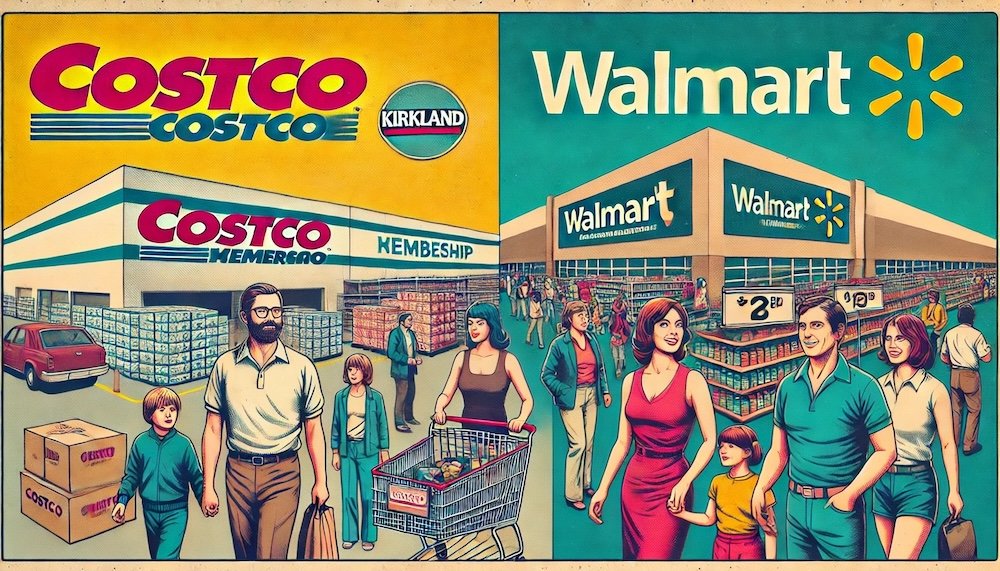
Customer Base and Market Positioning
Costco’s Niche: Middle- to High-Income Households
One of Costco’s defining characteristics is its appeal to middle- and upper-income consumers who have both the willingness and ability to pay for a membership. While the cost of a basic Costco membership is not prohibitively high—hovering around $60 per year—it still sets a psychological entry barrier for some shoppers. These members often expect to recoup the membership expense through the savings gleaned from bulk purchases. If a family goes through considerable quantities of groceries, paper products, and other household essentials, the cost-per-unit savings at Costco can be substantial over the course of a year.
Storage capacity is another factor. To truly reap the benefits of Costco’s bulk-centric approach, customers need ample pantry or freezer space. Many Costco customers live in larger suburban homes, where storing 24 rolls of paper towels or a year’s supply of trash bags is feasible. City dwellers with limited apartment space may find it more challenging to accommodate such large quantities, though Costco’s relatively recent push into urban areas has shown that some city-based shoppers will still make room for bargains.
Costco’s customer base also tends to view shopping as an “experience.” Roaming the expansive aisles, sampling free food offerings, and discovering unique or seasonal products fosters a sense of exploration. The brand’s private label, Kirkland Signature, further enhances loyalty by offering premium-quality merchandise at lower-than-expected prices. The combination of exclusivity (via membership) and perceived premium value has led Costco to be viewed favorably not just among middle-class families, but also among some affluent consumers who might otherwise shop at upscale grocers like Whole Foods or specialty markets.
Walmart’s Broad Appeal: Serving All Demographics
Walmart, in contrast, casts a wide net. From low-income families needing to stretch every dollar to middle-class or even upper-middle-class shoppers seeking time-efficient shopping, Walmart serves nearly every demographic group. Because there is no membership fee, it’s accessible to almost everyone—a crucial factor in Walmart’s success. Indeed, many rural communities and small towns depend on a local Walmart as their primary source for groceries, household goods, and pharmacy services.
Additionally, Walmart’s superstores include departments for automotive needs, electronics, sporting goods, and even garden centers, transforming them into one-stop destinations that can save shoppers time. This consolidated approach is especially valuable for busy individuals or families who prefer to make a single trip rather than visiting multiple specialty stores. Over the years, Walmart has faced some criticism for the impact of its superstores on local businesses, but it has also provided essential goods and job opportunities in smaller locales where retail options might be limited.
Moreover, Walmart’s brand is strongly associated with competitive prices. The company’s tagline of “Everyday Low Prices” reinforces the idea that shoppers don’t need to wait for special sales or use coupons extensively to score bargains. This resonates powerfully with many American households operating on tight budgets, especially in times of economic uncertainty or recession. Walmart’s pricing strategy appeals widely across income levels, although some higher-income consumers may still perceive Walmart as lacking the premium or curated feel they might find at Costco or niche grocers.
Branding and Perception
In the battle of public perception, Costco is often lauded for its employee pay, benefits, and overall operational ethics. The retailer has been frequently praised for paying workers above the industry average, which can lead to better service and lower turnover rates. This reputation extends to product quality, as many believe Costco is more selective about which brands grace its shelves. Indeed, seeing a product in Costco can be taken as a mark of trustworthiness or reliability.
Walmart, on the other hand, has sometimes faced public scrutiny around wages, labor practices, and the effect of its superstores on local communities. Nevertheless, Walmart has taken strides to improve its brand image by raising wages and investing in employee training programs. The store’s image is also gradually shifting with remodels, the integration of self-checkout machines to reduce lines, and expansions into healthier or organic product offerings. However, these initiatives haven’t yet fully erased the longstanding stereotypes or criticisms some consumers harbor.
Competitive Advantages
Given these distinct customer bases, both Costco and Walmart benefit from competitive advantages:
- Costco
- Membership Loyalty: Encourages repeat visits and high spending per trip.
- Treasure Hunt Environment: New and rotating items create excitement.
- Perceived Quality: Shoppers assume a level of vetting behind each product on the shelf.
- Lower Labor Turnover: Potentially higher-quality customer service.
- Walmart
- Convenience: One-stop shopping for everything from groceries to electronics.
- Massive Scale: Negotiates favorable supplier terms and supports competitive pricing.
- Location Ubiquity: Particularly in rural or suburban areas, Walmart may be the only major retailer.
- Price Leadership: Reinforces brand identity around affordability.
Cannibalization and Overlap
Interestingly, Walmart competes directly with Costco via Sam’s Club, a membership-based warehouse model that, in many respects, mirrors Costco’s. While Sam’s Club shares Walmart’s emphasis on low prices, it attempts to approximate the exclusivity and perceived quality that characterize Costco. When both Sam’s Club and Costco are present in a given area, they often vie for the same pool of membership-based shoppers.
It’s also worth noting that some households hold memberships to both warehouse clubs, finding that each has unique product offerings that justify multiple memberships. At the same time, a typical Costco shopper might still visit Walmart for convenience or to purchase smaller quantities of everyday items. These overlapping behaviors highlight the complexity of modern consumer choices: brand loyalty is not absolute, and convenience or specific product needs can drive shoppers across competing retail boundaries.
Tailoring the Experience
Because they target different segments, both companies tailor store layouts and merchandising strategies accordingly. Costco invests in a clean, streamlined warehouse environment, focusing on a limited number of SKUs, high-quality produce, and frequent product rotations. Walmart, in contrast, strives for broad accessibility and variety, with multiple store formats and departments to cover virtually every category a consumer might need. This difference helps solidify each brand’s identity and fosters the unique value proposition that sustains their respective customer bases.
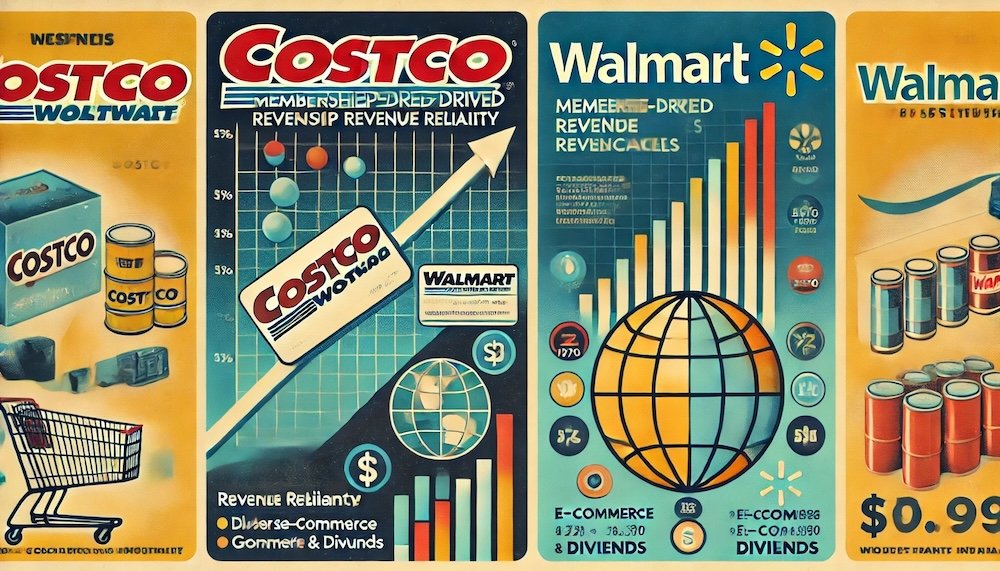
Investment Strategies and Stock Performance
Historical Stock Performance: A Snapshot
For many investors, Costco (COST) and Walmart (WMT) have long been pillars of stable growth within the retail sector. Over the past few decades, both companies have enjoyed generally upward-trending stock prices, though each responds differently to market shifts.
- Costco’s Share Performance often reflects its membership-driven reliability. Even when consumer spending dips, membership fees can buoy revenue, preserving earnings. Over the long term, this has led to steady gains in the share price. Investors frequently note that Costco tends to trade at higher valuations (such as a pricier price-to-earnings or P/E ratio) compared to many other retailers, signifying the market’s confidence in its unique model.
- Walmart’s Share Performance shows resilience grounded in the company’s sheer size and diversification. During economic downturns, Walmart can sometimes benefit from a “trading-down” effect, wherein customers leave higher-priced retailers and flock to Walmart’s everyday low prices. However, Walmart also operates internationally, which can introduce additional volatility, especially if certain global markets experience economic or political turmoil. Over time, though, Walmart has proven it can navigate changing consumer habits and competitive pressures, maintaining a generally stable upward trajectory.
Short sentences can be illustrative here: Costco is stable. Walmart is massive. Both are giants in retail. Each one adapts differently to shifting market conditions.
Dividend Policies and Share Buybacks
Walmart has a well-known record of paying and regularly raising its dividend. It is classified as a Dividend Aristocrat, which means it has increased its annual dividend payout for a significant stretch—25 years or more. This makes Walmart attractive to income-focused investors who seek reliable, increasing dividend checks. The company also engages in share repurchase programs, occasionally buying back large chunks of its own stock, which can help boost earnings per share and support the share price.
Costco also pays a regular dividend, though its yield is often smaller compared to Walmart’s. However, Costco has issued special dividends on multiple occasions, which can be quite large, offering shareholders a sudden windfall. This somewhat sporadic approach to returning capital can be appealing to investors who don’t necessarily need a predictable quarterly payout but still appreciate the potential for significant returns when Costco’s balance sheet brims with surplus cash. Some might argue that Costco’s model provides a balance between reinvesting for growth and rewarding shareholders.
Risk Profiles
Deciding which retail giant to invest in often boils down to evaluating risk and growth potential:
- Costco’s Risk Profile
- Steadier Cash Flow: Membership fees generate consistent revenue, lowering volatility.
- Limited SKUs and Minimal Debt: A more conservative approach to expansion can reduce risk but may also moderate rapid growth opportunities.
- Reliance on U.S. and Select International Markets: Costco’s strong performance in domestic suburban areas is an asset, but the international scope is less diverse than Walmart’s.
- Walmart’s Risk Profile
- Massive Scale: Provides stability but also means the company must constantly innovate to stay competitive.
- Global Exposure: Diversifies revenue streams but introduces currency and political risk.
- Larger E-Commerce Investments: Potentially higher growth but also heavier capital spending, which can pressure near-term earnings.
In essence, Costco’s model may be more straightforward and predictable for risk-averse investors who value consistent returns. Walmart, on the other hand, can offer broader diversification and possibly higher long-term growth, albeit with more volatility along the way.
Growth Trajectories and Future Outlook
Domestic Growth: In the U.S., both companies have saturated many local markets. Costco grows by carefully adding new warehouse clubs in areas it deems viable, typically focusing on affluent suburbs. Walmart often remodels existing stores and opens smaller Neighborhood Markets in communities where a full-scale Supercenter might not be warranted.
International Expansion: Costco’s cautious approach might leave growth opportunities on the table, but it also shields the company from costly missteps. Walmart, known for its aggressive expansions, has seen varied success internationally. Its foothold in Mexico (through Walmex) is notably strong, while it has exited or reduced presence in certain countries where cultural and competitive barriers proved formidable.
E-Commerce and Technology: Both retailers recognize that e-commerce is the future. Walmart has aggressively expanded online grocery services, built up third-party marketplaces, and even tested technologies like autonomous delivery vehicles. Costco, though slower to the e-commerce sphere, is taking incremental steps to shore up its digital channels, especially for bulky items more suitable for home delivery. As consumer habits evolve, the ability to merge in-store and online experiences seamlessly may dictate future success.
Sustainability and ESG Factors: Investors are increasingly weighing Environmental, Social, and Governance (ESG) considerations. Walmart has made pledges to reduce emissions and invest in renewable energy, while Costco also undertakes various initiatives to minimize its carbon footprint and champion ethically sourced products. Employee welfare can be another ESG focal point: Costco is widely admired for paying workers relatively high wages, whereas Walmart has drawn both praise for wage increases and criticism over labor practices. For investors seeking positive social or environmental impact, these factors can tip the scale toward one company or the other.
Portfolio Considerations
Some investors choose to hold both Costco and Walmart, recognizing that each brings a different form of resilience to a portfolio. The membership-based predictability of Costco can balance out Walmart’s broader market exposure. The combination provides two lines of defense in various economic cycles: if one experiences a hiccup, the other might offset it with stable performance. However, there is still correlation risk; both are in retail, so systemic shocks to consumer spending could negatively affect both at the same time.
On the other hand, those who prefer a simpler, more reliable growth trajectory might lean heavily on Costco, betting that the membership fees and consistent performance will offer decent, if not explosive, returns. Those seeking a more diversified retail behemoth with potential for expanded international and e-commerce growth might favor Walmart, particularly if they also value a strong, consistent dividend record.
Valuation Metrics: A Closer Look
Typical valuation metrics such as P/E ratio, price-to-sales ratio, or EV/EBITDA often reveal that Costco trades at a premium relative to Walmart and many other retailers. Advocates argue this premium is warranted because of Costco’s predictable membership income, consumer loyalty, and efficient operations. Critics may feel that Walmart’s relative “discount” in valuation, combined with its equally formidable presence, might provide better value for the price. Ultimately, much depends on how investors weigh growth prospects, risk tolerance, and personal preferences for each company’s operational ethos.
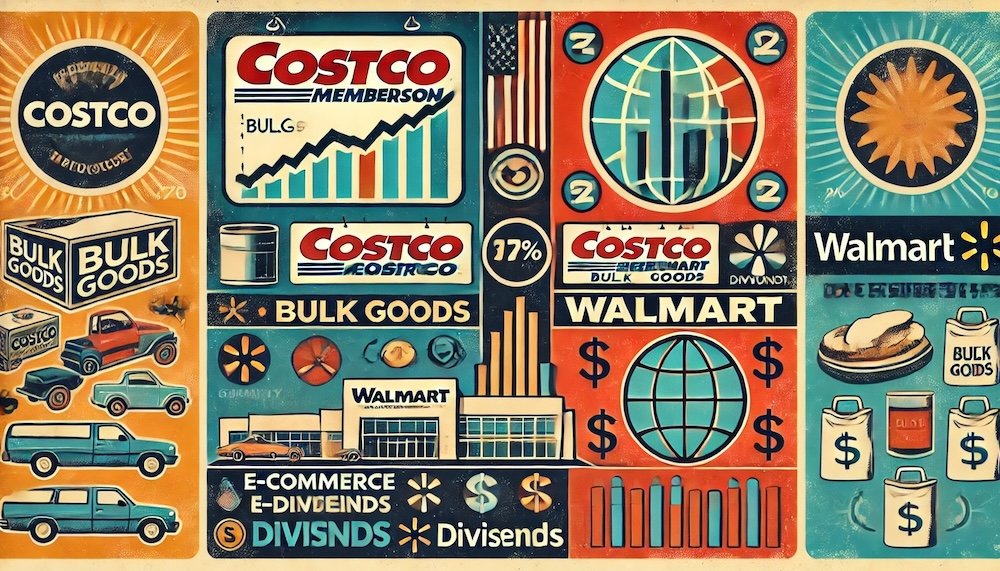
Costco vs. Walmart: 12-Question FAQ (Different Retail Models, Distinct Investor Goals)
How do Costco and Walmart fundamentally differ in business model?
Costco runs a membership-first, bulk warehouse model with limited SKUs and low merchandise margins, relying on subscription-like membership fees to power profitability. Walmart offers Everyday Low Prices to all shoppers, monetizing massive traffic across many formats (Supercenters, Neighborhood Markets, Sam’s Club) and channels (stores + e-commerce).
Where does each company’s profit really come from?
Costco’s merchandise is priced thinly; membership fees (renewals) are a key profit engine that smooths earnings. Walmart’s profit is spread across high-volume general merchandise and groceries, Sam’s Club, and a growing e-commerce/marketplace mix; operating scale and supply-chain efficiency protect razor-thin item margins.
Why do Costco’s margins look different from Walmart’s?
Costco intentionally targets very low merchandise gross margins and lets membership economics lift overall returns. Walmart must defend low prices across millions of SKUs and geographies; margin resilience comes from scale, mix, private label, and logistics improvements rather than subscriptions.
How important are private labels (Kirkland vs. Great Value/Equate)?
Kirkland Signature is central to Costco’s value perception—often “national-brand quality at lower cost,” boosting loyalty and mix. Walmart’s Great Value, Equate, Parent’s Choice and others widen its price ladder and improve margin mix at massive scale, though the brand halo is generally stronger at Costco.
Who shops where—and why?
Costco over-indexes to middle-/upper-income households with storage space and basket sizes that justify membership and bulk. Walmart spans all income tiers, with particular strength in value-seeking and rural shoppers who prize one-stop convenience and no membership requirement.
How are store formats and assortments different?
Costco: few SKUs, treasure-hunt rotation, large pack sizes, minimalist warehouses.
Walmart: broad SKU breadth across Supercenters, Neighborhood Markets, and Sam’s Club (Costco competitor), enabling weekly essentials + general merchandise + services in one trip.
Who is winning online?
Walmart has pushed harder into e-commerce, grocery pickup/delivery, and marketplace integrations—strategic to defending one-stop convenience digitally. Costco has select online categories and delivery partnerships; the in-warehouse experience and bulk economics remain its core moat, with digital as a complement.
How do international strategies compare?
Costco expands methodically into higher-income urban/suburban markets abroad to preserve the membership model’s economics. Walmart has broader global exposure (e.g., Mexico via Walmex) with varying outcomes—adding diversification but also FX, regulatory, and competitive complexity.
What about dividends and capital returns?
Walmart is a Dividend Aristocrat with consistent raises and ongoing buybacks, appealing to income investors. Costco’s regular dividend is modest, but it occasionally pays large special dividends, attractive to holders comfortable with irregular windfalls.
Why does Costco often trade at a premium valuation to Walmart?
Investors commonly pay up for Costco’s renewal-driven predictability, strong brand trust, and SKU discipline. Walmart often trades at a relative discount given scale/FX complexity and heavier investment needs, though its dividend durability and e-commerce traction argue for re-rating when execution is strong.
Key risks for each?
Costco: membership renewal sensitivity, constrained SKU breadth, slower e-commerce scaling, and affluence/geography concentration.
Walmart: global/FX/regulatory risk, structurally thin online margins, price wars, and execution risk across remodels, automation, and last-mile.
Which fits which investor profile?
Conservative/stability-seeking: Costco for subscription-like cash flows and loyalty flywheel.
Income & broad exposure: Walmart for dividend growth, buybacks, and diversified formats/geographies.
Barbell/balanced: Hold both—Costco’s membership resilience + Walmart’s omni/e-commerce scale to navigate varied cycles.
Conclusion: Costco vs Walmart
Costco and Walmart, two of the largest and most influential retailers in the world, embody different yet equally successful strategies in discount retail. Their journeys highlight that there is no singular method for thriving in a competitive industry. Instead, their success stems from clear market positioning, strong execution, and a willingness to adapt over time.
Key Takeaways
- Business Models and Operational Focus
- Costco builds loyalty through paid memberships and bulk-oriented product offerings, keeping merchandise margins low and compensating with recurring subscription fees.
- Walmart uses broad accessibility, massive scale, and a constantly refined supply chain to offer everyday low prices on an enormous range of goods.
- Revenue Streams and Profitability
- Costco relies on membership fees for a significant portion of profitability, which buffers economic swings and allows the retailer to consistently pass savings on to shoppers.
- Walmart has more diverse revenue streams, including e-commerce, financial services, and Sam’s Club, but typically operates on extremely tight margins to maintain its affordability promise.
- Customer Base and Market Positioning
- Costco tends to attract middle- to higher-income households comfortable with buying in bulk and paying a membership fee to secure savings. Its aura of exclusivity and “treasure hunt” shopping environment fosters loyal, repeat customers.
- Walmart serves a vast array of shoppers across income brackets, offering one-stop convenience, extensive product categories, and no membership requirement. For many rural or low-income communities, Walmart is the primary retail option.
- Investment Strategies and Stock Performance
- Costco’s stock is often seen as stable, backed by membership-fueled revenue and a consistently positive brand image. While its dividend yield is modest, special dividends can provide unexpected boosts.
- Walmart’s stock offers diversification via global reach, a robust e-commerce push, and a longstanding tradition of dividend increases. It can be subject to greater market volatility, but it appeals to investors seeking a blend of growth and income.
- Future Outlook
- Both retailers are navigating the evolving retail landscape, marked by increased online shopping, changing consumer habits, and emerging sustainability requirements.
- Costco is likely to keep methodically adding new warehouses in lucrative markets and carefully expanding e-commerce.
- Walmart will continue to refine its online strategy, possibly exploring new international markets and expanding its digital services to stay ahead in the e-commerce race.
Which Retailer Suits Which Investor?
- Conservative Investors: Costco’s predictable membership income, stable margins, and slower expansion may better align with your appetite for lower-risk investments.
- Income-Focused Investors: Walmart’s status as a Dividend Aristocrat, alongside regular share buybacks, might be more appealing if you want consistent dividend growth.
- Growth-Oriented Investors: Walmart’s global footprint and heavy investment in online platforms may offer opportunities for higher but more volatile returns, although Costco also has steady, long-term growth potential, albeit at a more measured pace.
- Balanced Portfolios: Holding both companies could hedge against certain types of market fluctuation—Costco’s membership-driven stability paired with Walmart’s broad-based scale and willingness to innovate in e-commerce.
In the end, Costco vs. Walmart is not a matter of which is “better” in absolute terms; it’s a matter of which aligns more closely with your goals, whether those are focused on investment returns, everyday savings, or both. Each retailer has plenty to offer, and each will likely continue to command a formidable share of the retail market for years—if not decades—to come.
Important Information
Comprehensive Investment Disclaimer:
All content provided on this website (including but not limited to portfolio ideas, fund analyses, investment strategies, commentary on market conditions, and discussions regarding leverage) is strictly for educational, informational, and illustrative purposes only. The information does not constitute financial, investment, tax, accounting, or legal advice. Opinions, strategies, and ideas presented herein represent personal perspectives, are based on independent research and publicly available information, and do not necessarily reflect the views or official positions of any third-party organizations, institutions, or affiliates.
Investing in financial markets inherently carries substantial risks, including but not limited to market volatility, economic uncertainties, geopolitical developments, and liquidity risks. You must be fully aware that there is always the potential for partial or total loss of your principal investment. Additionally, the use of leverage or leveraged financial products significantly increases risk exposure by amplifying both potential gains and potential losses, and thus is not appropriate or advisable for all investors. Using leverage may result in losing more than your initial invested capital, incurring margin calls, experiencing substantial interest costs, or suffering severe financial distress.
Past performance indicators, including historical data, backtesting results, and hypothetical scenarios, should never be viewed as guarantees or reliable predictions of future performance. Any examples provided are purely hypothetical and intended only for illustration purposes. Performance benchmarks, such as market indexes mentioned on this site, are theoretical and are not directly investable. While diligent efforts are made to provide accurate and current information, “Picture Perfect Portfolios” does not warrant, represent, or guarantee the accuracy, completeness, or timeliness of any information provided. Errors, inaccuracies, or outdated information may exist.
Users of this website are strongly encouraged to independently verify all information, conduct comprehensive research and due diligence, and engage with qualified financial, investment, tax, or legal professionals before making any investment or financial decisions. The responsibility for making informed investment decisions rests entirely with the individual. “Picture Perfect Portfolios” explicitly disclaims all liability for any direct, indirect, incidental, special, consequential, or other losses or damages incurred, financial or otherwise, arising out of reliance upon, or use of, any content or information presented on this website.
By accessing, reading, and utilizing the content on this website, you expressly acknowledge, understand, accept, and agree to abide by these terms and conditions. Please consult the full and detailed disclaimer available elsewhere on this website for further clarification and additional important disclosures. Read the complete disclaimer here.




